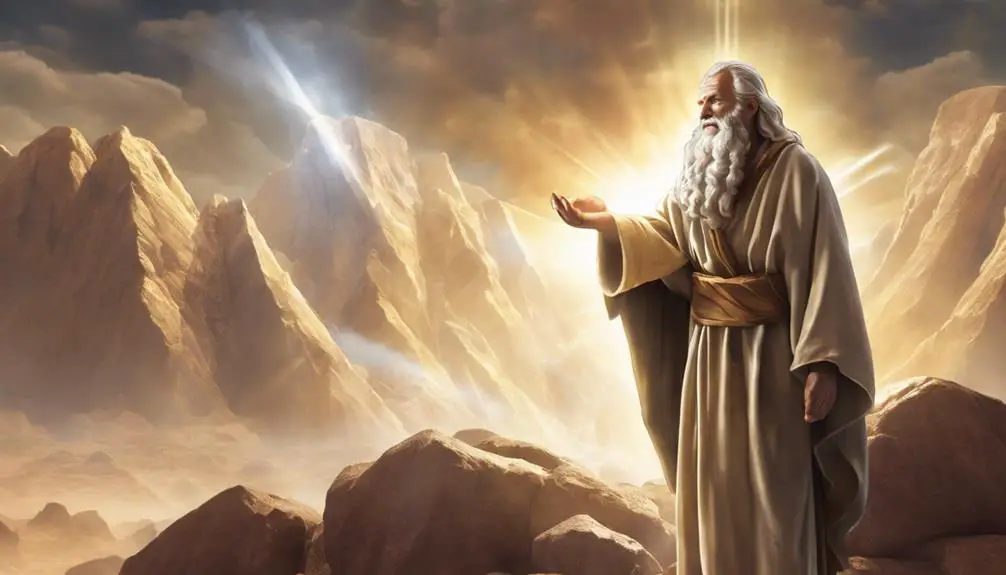Uncover the profound insights of the Bible's longest prayer, revealing timeless wisdom and a deeper connection to faith.

What Is the Longest Prayer in the Bible
While you might think the length of a prayer is inconsequential, the longest prayer in the Bible holds profound insights into faith, history, and the human condition. It's nestled within an ancient text, offering not only a glimpse into the speaker's heart but also reflecting the broader cultural and spiritual landscape of the time.
By exploring this prayer, you'll uncover key themes that resonate deeply with both personal faith and scholarly inquiry. The identity of the speaker and the historical context enrich its significance, inviting you into a deeper exploration of its impact on both past and contemporary understanding.
Key Takeaways
- The longest prayer in the Bible is found in Nehemiah 9:5-38, covering thirty-four verses.
- This prayer is distinctive for its combination of confession, praise, and recounting of history.
- It marks a shift in prayer from individual to communal, emphasizing collective responsibility and repentance.
- The prayer in Nehemiah 9 reflects deep themes of repentance, covenant, divine mercy, and the hope for renewal.
Identifying the Longest Prayer

When examining the biblical text, it becomes clear that the longest prayer is found in Nehemiah 9:5-38. Your scriptural analysis must take into account not just the prayer duration but the depth and breadth of its content. This prayer spans thirty-four verses, making it the most extensive single prayer recorded in the Bible. Unlike other prayers that might be brief and to the point, this one in Nehemiah intricately weaves together confession, praise, and a recounting of Israel's history, marking it as unique in both length and substance.
In understanding why this prayer stands out, you've got to consider its structure and components. The prayer meticulously covers the exodus from Egypt, the miraculous signs in the desert, and the giving of the law. It's not just about the quantity of words but the quality of its themes. This depth of scriptural analysis reveals the prayer's significance beyond its sheer duration. It encapsulates a profound spiritual journey, making its length not merely a matter of verbosity but of rich theological reflection.
Historical Context and Importance
Understanding the longest prayer in Nehemiah 9:5-38 also requires examining its historical backdrop to fully grasp its significance and the impact it had on Israelite society and faith. This prayer not only reflects the spiritual depth and repentance of the Israelites but also marks a significant point in the evolution of prayer within their community. It's a vivid testament to the cultural significance that prayer held, serving as both a communal confession and a historical recount of their relationship with God.
Aspect |
Impact on Society & Faith |
|---|---|
Historical Context |
Shaped understanding of communal sin and redemption |
Prayer Evolution |
Transition from individual to communal prayer practices |
Cultural Significance |
Strengthened identity and unity among Israelites |
Spiritual Depth |
Encouraged deep reflection and repentance |
Communal Confession |
Fostered a sense of collective responsibility |
Analyzing this prayer within its historical context reveals much about the societal values and spiritual aspirations of the Israelites at that time. It's a clear indicator of how cultural dynamics and religious practices intertwine, shaping not only individual but communal identities. This historical insight into the prayer's context enriches our understanding of its profound impact and the evolution of prayer practices in ancient societies.
The Speaker's Identity

Delving into the identity of the speaker in Nehemiah 9:5-38, it's crucial to recognize this figure not merely as an individual but as a representative voice of the Israelite community, embodying their collective spiritual journey and repentance.
The speaker's background and rhetorical style are pivotal in understanding the depth of the prayer. Here's what sets this speaker apart:
- Position of Authority: The speaker holds a significant position within the Israelite community, allowing them to articulate the collective sentiments and confessions of the people.
- Spiritual Leadership: Their role isn't just administrative but deeply spiritual, guiding the community through a process of reflection and repentance.
- Historical Awareness: The speaker demonstrates a profound understanding of Israel's history, weaving it seamlessly into the prayer's fabric.
- Rhetorical Mastery: Their use of language is both powerful and persuasive, crafted to stir the hearts of the listeners and invoke a communal sense of identity and purpose.
- Emotional Depth: The prayer is imbued with genuine emotion, reflecting the speaker's deep personal and communal bonds with both the people and God.
Analyzing the speaker's identity reveals a figure deeply intertwined with the Israelite community's spiritual DNA, embodying their hopes, regrets, and aspirations through a masterful display of rhetorical eloquence.
Key Themes and Lessons
Exploring the key themes and lessons of Nehemiah 9:5-38, you'll uncover a rich tapestry of repentance, covenant, and divine mercy that resonates deeply with the spiritual journey of the Israelite community. This passage not only recounts their physical journey but delves into the spiritual odyssey, marked by moments of divine petition and prayerful endurance. As you dissect this prayer, it's evident that the Israelites' plea for God's mercy is intertwined with their acknowledgment of past mistakes.
Theme |
Significance |
|---|---|
Repentance |
It underscores the community's recognition of their transgressions and their sincere return to divine guidance. |
Covenant |
Highlights the unbreakable bond between the divine and the Israelites, despite their periodic faithlessness. |
Divine Mercy |
Demonstrates God's unfailing compassion and willingness to forgive, reinforcing the hope for renewal. |
This narrative isn't just a historical recount; it's a reflection on the importance of humility, the strength found in acknowledging one's failings, and the perpetual hope that divine mercy offers. The themes of divine petition and prayerful endurance encapsulate the essence of a relationship with the divine that is both challenging and rewarding.
Impact on Faith and Scholarship

Reflecting on the themes of repentance, covenant, and divine mercy in Nehemiah 9:5-38 reveals their profound influence on both personal faith and academic scholarship. This prayer not only showcases the diversity inherent in biblical prayers but also opens up avenues for modern interpretations that resonate with contemporary believers and scholars alike. By delving into its rich theological content, one can uncover the multifaceted ways in which this prayer impacts faith and scholarship:
- It highlights the importance of historical confession in spiritual practice, encouraging personal and communal reflection.
- The prayer's emphasis on covenantal faithfulness challenges believers to consider their own fidelity to divine promises.
- Its detailed recounting of Israel's history serves as a critical resource for theologians and historians, offering insights into ancient religious and cultural contexts.
- The diversity of petitions within the prayer reflects a broad spectrum of human interaction with the divine, enriching the study of prayer forms in religious scholarship.
- Modern interpretations of this prayer engage with contemporary issues of justice, mercy, and community, demonstrating its relevance and applicability across ages.
These aspects underscore the prayer's significant role in nurturing a deeper understanding and practice of faith, while simultaneously enriching academic discourse in theology and religious studies.
Frequently Asked Questions
How Has the Longest Prayer in the Bible Influenced Modern Liturgical Practices?
You'll find that the prayer's length has significantly impacted modern liturgical practices, introducing a variety of liturgical innovations. Scholars analyze how its extensive narratives and petitions have inspired more elaborate and reflective elements in today's worship services.
This adaptation has led to a deeper engagement with the spiritual aspects of liturgy, allowing worshippers to immerse themselves more fully in prayerful experiences, thus enriching the communal and individual worship experience.
Are There Any Specific Musical Compositions Inspired by the Longest Prayer in the Bible?
You'll find that several musical compositions are inspired by the text you're curious about. These pieces span various musical genres, incorporating diverse composition techniques that reflect the prayer's depth and complexity.
Composers often explore rich harmonies and intricate textual settings to mirror the prayer's emotional range. This approach not only showcases their technical prowess but also deepens listeners' engagement with the prayer through a unique auditory experience.
How Do Various Religious Denominations Interpret the Theological Implications of the Longest Prayer Differently?
You'll find that prayer length debates highlight deep theological divides yet also offer a path to denominational unity.
Different religious groups interpret the theological implications in varied ways, reflecting their unique doctrines and traditions. This diversity in interpretation showcases the rich tapestry of faith perspectives, yet, interestingly, it also serves as a common ground for dialogue.
Analyzing these differences not only broadens your understanding but also emphasizes the core values shared across denominations.
What Are Some Notable Artistic Representations (Paintings, Sculptures, Etc.) of the Longest Prayer in the Bible?
You'll find the artistic landscape dotted with masterpieces that breathe life into the longest prayer, transforming words into visual symphonies.
Through sculptures that seem to whisper ancient secrets and paintings that stretch like endless horizons of devotion, artists have deeply explored prayer symbolism.
At exhibition events, these pieces invite scholarly analysis, urging a closer look at the nuanced interpretations and the profound impact of this prayer on artistic expression throughout history.
How Has the Longest Prayer Been Utilized in Contemporary Spiritual or Mindfulness Practices Outside of Traditional Religious Contexts?
You'll find the longest prayer has been woven into modern spiritual practices, particularly outside traditional religious settings. Mindfulness apps often feature it in guided meditations, using its words to anchor the mind and foster a sense of peace.
Similarly, yoga sessions incorporate it into their routines, not just as a physical exercise, but as a spiritual practice to deepen participants' connection to their inner selves and the universe. This integration highlights its timeless relevance and adaptability.
Conclusion
As you've journeyed through the depths of the longest prayer in the Bible, you've uncovered a treasure not just of words, but of profound spiritual insight.
Imagine standing before a vast ocean—the prayer's historical depth, thematic richness, and scholarly significance stretch before you, inviting endless exploration.
This prayer, much like an ocean, is both awe-inspiring and humbling, reminding us of the immense wisdom and beauty contained within the sacred texts that shape our faith and understanding.



Sign up